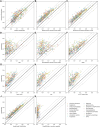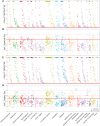A deep learning phenome wide association study of the electrocardiogram
- PMID: 40703109
- PMCID: PMC12282379
- DOI: 10.1093/ehjdh/ztaf047
A deep learning phenome wide association study of the electrocardiogram
Abstract
Aims: Deep learning methods have shown impressive performance in detecting a range of diseases from electrocardiogram (ECG) waveforms, but the breadth of diseases that can be detected with high accuracy remains unknown, and in many cases the changes to the ECG allowing these classifications are also opaque. In this study, we aim to determine the full set of cardiac and non-cardiac conditions detectable from the ECG and to understand which ECG features contribute to the disease classification.
Methods and results: Using large datasets of ECGs and connected electronic health records from two separate medical centres, we independently trained PheWASNet, a multi-task deep learning model, to detect 1243 different disease phenotypes from the raw ECG waveform. We confirmed that the ECG can be used to detect chronic kidney disease (AUC = 0.80), cirrhosis (AUC = 0.80), and sepsis (AUC = 0.84), as well as a range of cardiac diseases, and also found new detectable conditions, including respiratory failure (AUC = 0.86), neutropenia (AUC = 0.83), and menstrual disorders (AUC = 0.84). We found that of the 37 non-cardiac strongly detectable conditions, 35 were detectable by the model output for just four diseases, suggesting that they have similar effects on the ECG. We found that high performance in some conditions including neutropenia, respiratory failure, and sepsis can be explained by linear models based on conventional measurements taken from the ECG.
Conclusion: Our study uncovers a range of diseases detectable in the ECG, including many previously unknown phenotypes, and makes progress towards understanding ECG features that allow this detection.
Keywords: Artificial intelligence; Disease screening; Electrocardiogram; Phewas.
© The Author(s) 2025. Published by Oxford University Press on behalf of the European Society of Cardiology.
Conflict of interest statement
Conflict of interest: None declared.
Figures



References
-
- Attia ZI, Kapa S, Lopez-Jimenez F, McKie PM, Ladewig DJ, Satam G, et al. Screening for cardiac contractile dysfunction using an artificial intelligence–enabled electrocardiogram. Nat Med 2019;25:70–74. - PubMed
-
- Vrudhula A, Hughes JW, Yuan N, Ouyang D. The impact of task set-up in algorithm design: regression versus classification. NEJM AI 2024;1:AIcs2300176.
-
- Elias P, Poterucha TJ, Rajaram V, Moller LM, Rodriguez V, Bhave S, et al. Deep learning electrocardiographic analysis for detection of left-sided valvular heart disease. J Am Coll Cardiol 2022;80:613–626. - PubMed
-
- Attia ZI, Noseworthy PA, Lopez-Jimenez F, Asirvatham SJ, Deshmukh AJ, Gersh BJ, et al. An artificial intelligence-enabled ECG algorithm for the identification of patients with atrial fibrillation during sinus rhythm: a retrospective analysis of outcome prediction. Lancet 2019;394:861–867. - PubMed
LinkOut - more resources
Full Text Sources
